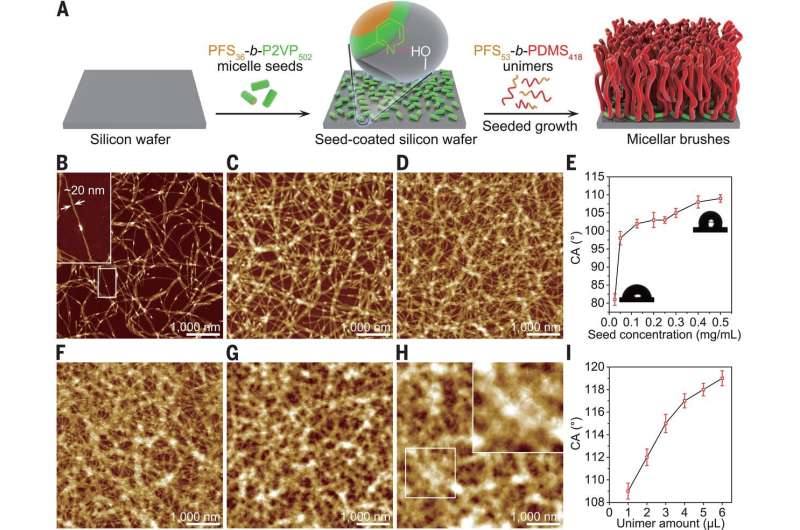November 29, 2019 report
Functionalized surfaces: Cylindrical micellar brushes with controlled length tailored chemical options

A team of researchers affiliated with multiple institutions in China has developed a way to functionalize surfaces with cylindrical micelle brushes with controlled length and tailored chemical options. In their paper published in the journal Science, the group outlines their method, give specific examples, and discuss possible uses for it. Alejandro Presa Soto with the University of Oviedo has published a Perspective piece in the same journal issue discussing the importance of patterned surface design and its many uses, along with a discussion of the work done by the team in China.
As Presa Soto notes, the design of patterned surfaces in a rational manner represents new avenues for fine-tuning composition and chemical functionality in base materials. He further notes that doing so in ways that can be expanded for use with other materials is optimal. In this new effort, the team in China has done just that. They have developed a bottom-up strategy for fabrication of nanostructures on a host of different surfaces.
The method by the team involved starting with PFS crystallite and poly(2-vinylpyridine) micelle seeds placed on the substrate. Doing so resulted in PFS copolymers growing epitaxially from the seeds. Next, cylindrical micellar brushes formed due to crystallization self-assembly. That was followed by unimers switching to PFS-P2VP—resulting in the formation of comicelles. In their example (using graphene oxide and silicon wafers), attachment occurred due to hydrogen bonding between pyridine groups of P2VP coronas and the hydroxyl groups. The researchers note that the ends of the crystallite seeds had PFS cores which remained active, allowing for the addition of more PFS-based BCPs. They further note that the micellar brushes could be functionalized specifically at the coronas by using gold nanoparticles that are able to catalyze certain chemical reactions. They suggest the technique could be used for allowing control over multiple properties of a surface such as length, density and chemistry—using micellar brushes. They further suggest the brushes could be outfitted with other molecules or nanoparticles to facilitate different sorts of catalysis, chemical separation or even antibacterial applications. Presa Soto notes that the approach is a step forward in the search for general and simple ways to create functional surfaces that have specific chemical properties.
More information: Jiandong Cai et al. Tailored multifunctional micellar brushes via crystallization-driven growth from a surface, Science (2019). DOI: 10.1126/science.aax9075
Journal information: Science
© 2019 Science X Network



















